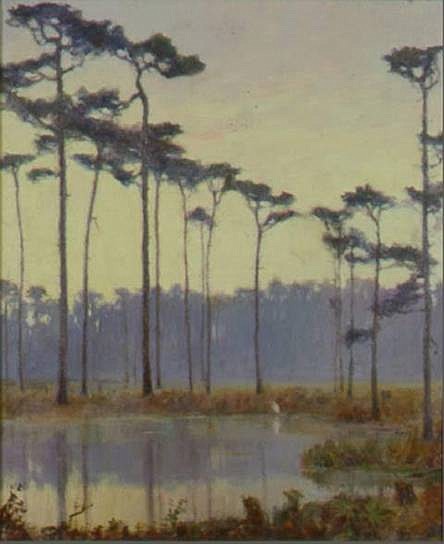William Silva, popularly known as Billy, was born in Savannah, Ga., on Oct. 23, 1859. The grandson of a Portuguese immigrant from the Azores, he was educated at the Chatham Academy and briefly studied engineering at the University of Virginia.
His parents, James Sylvester and Margaret Susan Askew Silva, established a china business on Market Street in Chattanooga, where their son joined them as a partner about 1887.
He began to paint recreationally; from 1900 to 1905 he spent summers studying composition with Arthur Wesley Dow in Ipswich, Mass. He also became friends with the artist and writer Emma Bell Miles, who lived on Walden's Ridge near Chattanooga.
In 1906, Silva's wife, Caroline Walker Beecher, encouraged him to sell the business and become a professional artist. With their son Abbott Beecher enrolled at Yale, the couple sailed for France, where Silva studied at the Academie Julien in Paris with Jean Paul Laurens and Henri Royer. He also studied with the American landscape painter Chauncey Foster Ryder in Etaples, France. Silva had showings at the Salon d'Automne in 1908 and a solo exhibition at the George Petit Gallery in 1909.
In 1910, Silva returned to Chattanooga and won the silver prize at the Appalachian Exposition in Knoxville. He also had a one-man show at the Gibbes Art Gallery in Charleston, S.C., traveled to New York City, and returned to Massachusetts to study with Arthur Dow.
Over the next three years, he spent time in New Orleans and other Southern cities and wintered in Washington, D.C., where he was active in the Society of Washington Artists. He demonstrated an interest in the wider artistic community with the publication of his article "Newcomb Pottery" in Art and Progress 2 (June 1911).
In 1913, the Silvas moved to Carmel, Calif., their "land of promise." They joined a large colony of artists and writers, including novelists Alice McGowan and Grace McGowan Cooke, former Chattanoogans who had moved there in 1908.
The Silvas purchased a bungalow and built a studio in the dunes off Carmelita Street, where Silva established the Carmelita Art Gallery. He won silver medals at the Panama-Pacific International Exposition in 1915. Between 1914 and the 1930s his work frequently appeared in major West Coast museums and galleries. He was an exhibiting member of the Carmel Arts & Crafts Club from 1913 to 1923 and exhibited at the Carmel Art Association between 1939 and 1947.
He and his wife were active in the Carmel community. Silva helped paint sets for the Forest Theater, where the MacGowan sisters had played major roles in the first production on July 9, 1910. The Silvas also served on the Fire Commission, took legal action to preserve the town's old growth trees (perhaps influenced by their son Abbott, a forester), joined the Carmel Pistol Club, vocally supported Prohibition and sought to ban the local chapter of the John Reed Club.
Silva widely exhibited his work not only in California and the South, but also at the Salamagundi Club in New York, the Corcoran Gallery of Art in Washington, D.C., and the Pennsylvania Gallery of the Fine Arts in Philadelphia.
He remained involved in the Southern States Art League based in New Orleans and often revisited the Southeast. He was given a solo exhibition at the Telfair Academy in Savannah in 1917and again after his death in 1948.
In the 1920s, Silva participated in the Charleston Renaissance, producing many scenes of the Carolina low country in an impressionistic style that captured the feel of coastal marshlands and beaches. He traveled widely in search of subject matter in Alabama, Mississippi, Tennessee, Texas and Louisiana.
After the death of his wife in 1940, Silva married Ruth Lewis. He died at the age of 88 on Feb. 10, 1948 and his ashes were sent to the family crypt in Savannah. For several years thereafter Abbott sold his father's paintings at the Carmelita Art Gallery, and today several galleries offer them for sale on the internet.
American art historian William H. Gerdts wrote in "Art Across America" (1990) that he considered William Posey Silva our "finest artist at the turn of the century." His work can be seen in the Johnson Collection in Spartanburg, S.C., the Gibbes Museum of Art in Charleston, S.C., and the Tennessee State Museum and Cheekwood Botanical Garden and Museum of Art in Nashville.
Kay Baker Gaston is a regional historian and former Chattanoogan. For more, visit Chattahistoricalassoc.org.
